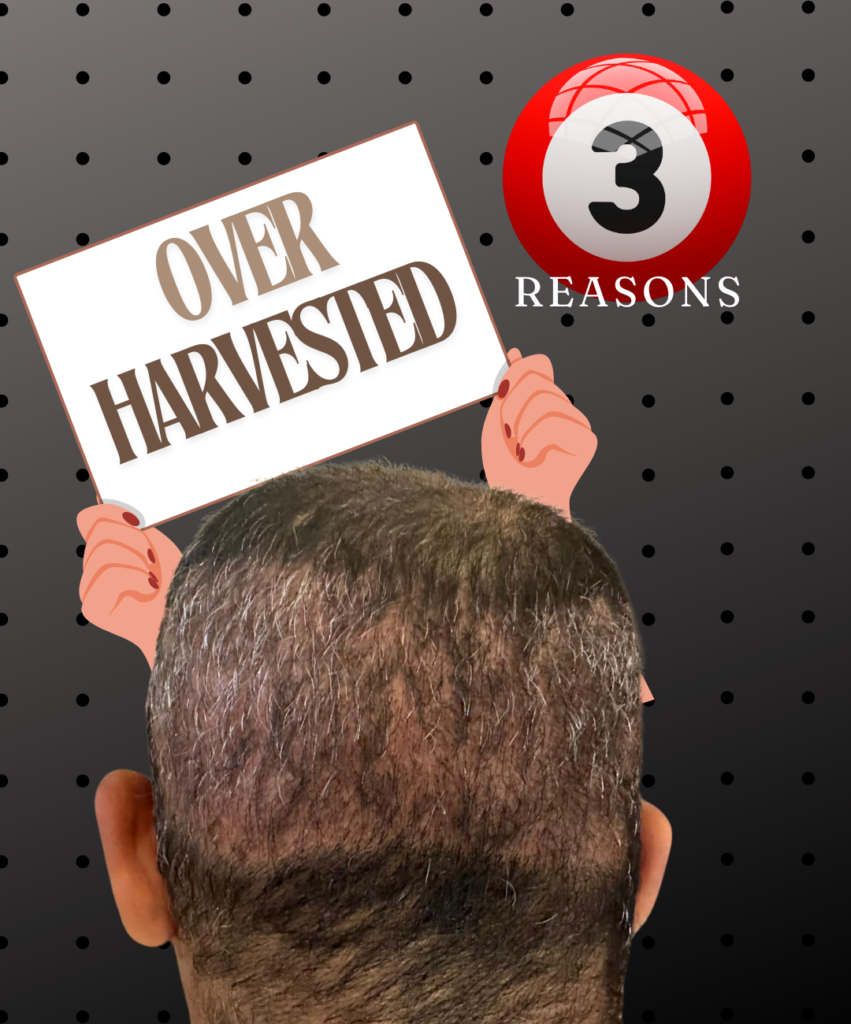Overharvesting in hair transplantation refers to the excessive extraction of donor hair follicles beyond the safe donor area, leading to visible scarring, thinning, or depletion of the donor zone. This phenomenon is a critical issue in hair restoration, as it not only compromises the aesthetic outcome but also the long-term viability of the donor area for potential future procedures. Three principal factors contribute to overharvesting and the subsequent scarring. And I discuss them below
1. Skill and Technique
The first and arguably the most crucial factor in overharvesting is the surgeon’s skill and technique. Hair transplantation is a highly delicate procedure that demands meticulous attention to detail, precision, and experience. Surgeons with inadequate training or insufficient experience may fail to adhere to the principles of proper follicular unit extraction (FUE) technique. Overharvesting often results from inaccurate estimation of the number of grafts that can safely be extracted from the donor area. A skilled surgeon must be able to evaluate donor density and ensure that the spacing between harvested follicles is sufficient to prevent noticeable thinning and scarring. Furthermore, improper angulation or depth control during extraction can damage the surrounding tissue and follicles, increasing the risk of scarring. Surgeons must be well-versed in minimizing transection rates—where the follicle is damaged during extraction—through precise and controlled movements. The mantra “less is more” applies here, as an overzealous approach can quickly turn an aesthetic procedure into a disfiguring outcome.
2. Instruments and Punch Size
The instruments used during the procedure, especially the size and quality of punches, also play a significant role in causing scarring due to overharvesting. The punch is a cylindrical instrument used to extract hair follicles during FUE, and its diameter is a critical factor in determining both the quality of the grafts and the degree of trauma inflicted on the donor area. Larger punches (greater than 1.0 mm in diameter) tend to cause more trauma to the scalp, increasing the risk of visible scarring post-operatively. On the other hand, smaller punches (ranging from 0.7 to 0.9 mm) are generally preferred because they cause less tissue damage and preserve the aesthetic integrity of the donor area. However, even with smaller punches, improper handling can result in overharvesting. Overuse of the same extraction sites, aggressive punching, excessive heat causing localised burns and wobbling of reused punch can all lead to scarring and unsightly outcomes. The surgeon’s choice of tools must balance efficiency with the preservation of tissue integrity, as careless tool selection or misuse can have lasting repercussions for the patient.
3. Improper Case Selection
A third cause of overharvesting is improper case selection, which can lead to irreversible scarring if not addressed. Not all patients are suitable candidates for extensive FUE procedures. Factors such as donor density, hair characteristics (e.g., curliness, coarseness), and the extent of hair loss must be considered before committing to a large number of grafts. Patients with a limited donor supply, diffuse thinning, or certain underlying scalp conditions may not have the donor reserve necessary to achieve the desired cosmetic results without risking overharvesting. Additionally, when a patient has a high demand for grafts, particularly in cases of advanced hair loss (Norwood Class VI or VII), aggressive harvesting may be required to meet expectations. Unfortunately, this often results in the overextraction of hair follicles, creating patchy or moth-eaten donor areas. Ethical surgeons will prioritize patient education, emphasizing the limitations of what can be achieved without compromising the donor area’s integrity. Furthermore, evaluating the patient’s long-term needs, including potential future hair loss, helps guide the extent of harvesting, ensuring the donor area remains viable for future sessions if necessary.
Conclusion
Overharvesting and the scarring that follows it are preventable with proper technique, careful selection of tools, and thorough patient assessment. Surgeons who are well-trained, experienced, and ethically conscious understand the balance required between achieving satisfactory immediate results and preserving the patient’s long-term aesthetic and follicular health. Hair transplantation is an art as much as it is a science, and by respecting the delicate nature of the donor area, both scarring and the detrimental effects of overharvesting can be minimized. The consequences of not adhering to these principles are not just cosmetic, but can have a profound impact on the patient’s psychological and emotional well-being, leaving scars that run far deeper than the skin.


